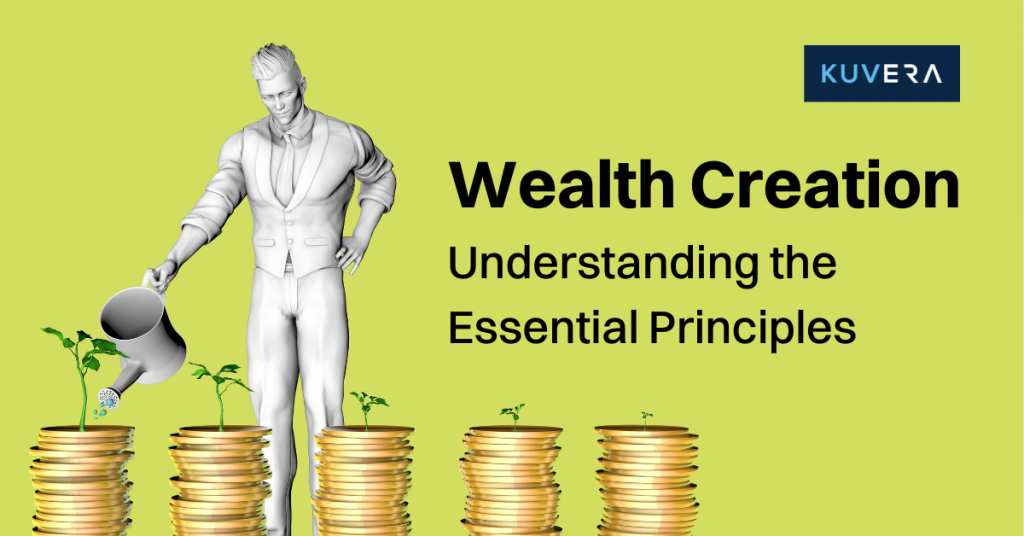
This is a guest post authored by the team at Bandhan Mutual Fund, one of India’s leading fund houses with ₹1,41,319 cr of Assets under Management as of 29 Feb 2024.
It is widely acknowledged now that it is not your salary that can make you rich but rather how you manage and allocate it. Wealth is not only something we desire but an essential component of living a fulfilling life. The more one can accumulate it the better the chances of a better life. This is why one must understand the tenets of wealth creation. Let’s read through.
1. What is Wealth Creation – Definition and Concept:
Wealth creation, as the name suggests, is expanding on your assets over a period of time. To build wealth one requires to engage in intensive study, research, and financial planning. Saving and investments are the two most important pillars to increase wealth. The concept of wealth creation involves a combination of a strategic investment plan, which is identifying a successful and suitable investment opportunity, supported by clearly defined financial goals for different stages of one’s life and the ability to take financial and market risks.
2. Saving vs. Investing
Saving and investments are two sides of the same coin, as both are necessary elements of a sound financial journey.
Savings are crucial to meet short-term goals and emergencies while investing has the potential to deliver higher returns to realise long-term objectives. Saving accounts with banks is the most common method of savings, while there are a plethora of investment avenues like stock market trading, real estate investments, and mutual funds. Some of the key differences between investing are highlighted in the table below:
| No. | Difference | Savings | Investments |
| 1 | Guarantee on returns | One can be assured of the interest generated in the savings bank account | Returns from investment products like mutual funds are not guaranteed particularly in the short run due to market fluctuations |
| 2 | Yield of returns | The interest rates are lower. Going by the current savings bank rate in India the interest on saving is 2.75-2.90% | Investment in stock markets and other instruments like debt and commodities can help yield higher double-digit returns in many cases in the range of 20-25% |
| 3 | Liquidity | They are liquid which means the deposits can be immediately tapped or withdrawn. | Most investment products are also liquid and can allow investors to exit on short notice. However, some investment plans may have a lock-in period, while many are also beneficial on completion of the maturity period in terms of achieving one’s financial goals. |
| 4 | Risks | Associated risks with savings is comparatively low. One is unlikely to face financial losses with savings account | As markets are generally volatile there can be a high risk of facing heavy losses. |
| 5 | Tackling inflation | Savings account may not be able to generate sufficient corpus to outpace rising inflation. | Over an extended period of 5-8 years and above the wealth generated through investments can help compensate for the rise in inflation by enhancing the purchasing power. |
3. Compounding – The ultimate tenet of wealth creation
Compounding can be termed as the foundation of wealth creation. The concept of compounding refers to the process of one’s investments and returns on investment earning a return. For instance, if you have invested Rs 100 in an investment scheme and earn a 10% annual return on the investment you would have accumulated a total of Rs. 110, including a return of Rs 10, in the first year. If you go ahead and reinvest the entire amount of Rs 110 for the second year then at an indicative rate of 10% interest your investment amount on Rs 110, you will have generated a profit of Rs 11 this time, and your investment amount will climb upto Rs 121. If you keep reinvesting the money, there is strong potential that your returns will keep getting higher over the years.
The golden rule to follow for compounding to yield desired results is to first start investing at an early stage and stay invested to generate the optimal level of returns.
4. How much of your salary you should invest:
Experts popularly recommend the 50:30:20 rule for salaried individuals to estimate the amount for investment purposes. This rule simply states that 50% of one’s income must be reserved for necessities and daily expenses like groceries, EMIs rent, etc. 30% can be kept aside to fulfill certain lifestyle needs like vacations, shopping, or health-related or hobby-related vocations. the remaining 20% corpus can be utilized to build emergency funds and achieve long-term financial goals like buying a house, funding children’s education, and preparing for retirement. Channeling funds from wasteful and unproductive expenditures towards informed investment avenues that can help generate wealth can be the smart thing to do. It is crucial to evaluate the level of risk one is willing to take with their hard-earned money before any investment decisions.
5. Importance of investing for the long-term
Most of us have observed the market behavior to be extremely volatile. To add to this aspect is the near impossibility of predicting the upward and downward movement of the markets. Historically though, it has been noticed that any losses arising out of market fluctuations tend to even out in the long run. If markets fall, eventually they have picked up again. A portfolio built on the premises of a long-term investment objective is more likely to ride out the downside risks and help achieve the financial objectives.
6. Significance of emotional detachment and keeping biases in check:
For capital markets investors it is essential to act in a way that is inversely related to your emotions. Let us explain, as already mentioned, that stocks are frequently in either an uptrend or a downtrend. Generally, a downward trend triggers panic and fear of potential investment losses. However, a downward spiral is not necessarily a cause for alarm but an opportunity to buy more at a lesser cost. It should be noted however that every investment action must be based on rational and informed decisions. Similarly, one should also avoid biases, such as an unfounded preference for a company and its shares, particularly if certain red flags are raised indicating that it is time to exit the investment.
Conclusion: Wealth creation should be based on healthy and informed investment planning. One can seek advice from a financial advisor to help define a financial plan.
The opinions expressed are those of the authors and should not be construed as advice from Kuvera.
DISCLAIMER:
MUTUAL FUND INVESTMENTS ARE SUBJECT TO MARKET RISKS, READ ALL SCHEME RELATED DOCUMENTS CAREFULLY.
The Disclosures of opinions/in house views/strategy incorporated herein is provided solely to enhance the transparency about the investment strategy / theme of the Scheme and should not be treated as endorsement of the views / opinions or as an investment advice. This document should not be construed as a research report or a recommendation to buy or sell any security. This document has been prepared on the basis of information, which is already available in publicly accessible media or developed through analysis of Bandhan Mutual Fund. The information/ views / opinions provided is for informative purpose only and may have ceased to be current by the time it may reach the recipient, which should be taken into account before interpreting this document. The recipient should note and understand that the information provided above may not contain all the material aspects relevant for making an investment decision and the security may or may not continue to form part of the scheme’s portfolio in future. Investors are advised to consult their own investment advisor before making any investment decision in light of their risk appetite, investment goals and horizon. The decision of the Investment Manager may not always be profitable; as such decisions are based on the prevailing market conditions and the understanding of the Investment Manager. Actual market movements may vary from the anticipated trends. This information is subject to change without any prior notice. The Company reserves the right to make modifications and alterations to this statement as may be required from time to time. Neither Bandhan Mutual Fund (formerly known as IDFC Mutual Fund)/ Bandhan Mutual Fund Trustee Limited (formerly IDFC AMC Trustee Company Limited) / Bandhan AMC Limited (formerly IDFC Asset Management Company Limited), its Directors or representatives shall be liable for any damages whether direct or indirect, incidental, punitive special or consequential including lost revenue or lost profits that may arise from or in connection with the use of the information.
Interested in how we think about the markets?
Read more: Zen And The Art Of Investing
Want to know more about Index Funds?
Watch/hear on YouTube:
Start investing through a platform that brings goal planning and investing to your fingertips. Visit kuvera.in to discover Direct Plans and start investing today.

